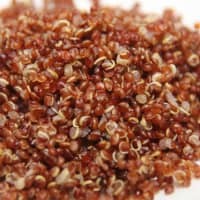Quinoa is a flowering plant in the amaranth family. It is grown as a crop primarily for its edible seeds.
Quinoa is a pseudocereal botanically related to spinach and amaranth (Amaranthus spp.).
Composition / Nutritional Value
The seeds are rich in protein, dietary fiber, B vitamins, and dietary minerals in amounts greater than in many grains.
Nutritional evaluations indicate that a 100-gram (3 1⁄2-ounce) serving of raw quinoa seeds is a rich source of protein, dietary fiber, several B vitamins, including 46% DV for folate, and the dietary minerals magnesium, phosphorus, and manganese.
After cooking, which is the typical preparation for eating the seeds, quinoa is 72% water, 21% carbohydrates, 4% protein, and 2% fat.
In a 100 g (3 1⁄2 oz) serving, cooked quinoa provides 503 kilojoules (120 kilocalories) of food energy and is a rich source of manganese and phosphorus (30% and 22% DV, respectively), and a moderate source (10–19% DV) of dietary fiber, folate, and the dietary minerals, iron, zinc, and magnesium.
Quinoa is gluten-free.
Because of the high concentration of protein, ease of use, versatility in preparation, and potential for increased yields in controlled environments, it has been selected as an experimental crop in NASA’s Controlled Ecological Life Support System for long-duration human occupied space flights.
Preparation
Uncooked quinoa seeds and sprouts contain a toxic protein, quinoin.[1] Quinoin is cytotoxic against human fibroblasts and human keratinocytes.[1:1] However, these toxic proteins lose activity after 10-min incubation at 70°C.[1:2]
Therefore thermal treatment of quinoa seeds and sprouts (minimum 10-min incubation at 70°C) is recommended before consumption in order to inactivate toxins.[1:3]
Healing Properties
Heart Health
Cardiovascular Disease (CVD)
Weight Loss
Quinoa seed supplementation significantly lowered the body weight.[2]
Title: Quinoa as source of type 1 ribosome inactivating proteins: a novel knowledge for a revision of its consumption
Publication: Journal of Food Chemistry
Date: October 2020
Study Type: Human Study: In Vitro
Author(s): Nicola Landi, Maria Rosaria Ruocco, Sara Ragucci, Federica Aliotta, Rosarita Nasso, Paolo V. Pedone, Antimo Di Maro
Institution(s): University of Campania ‘Luigi Vanvitelli’, Via Vivaldi, Italy; University of Naples, Italy
Abstract: This study investigates on the presence of toxic proteins in quinoa seeds. To this aim, a plethora of biochemical approaches were adopted for the purification and characterization of quinoin, a type 1 ribosome-inactivating protein (RIP) contained in quinoa seeds. We determined its melting temperature (68.2±0.6°C) and thermostability (loss of activity after 10-min incubation at 70°C). Considering that quinoa seeds are used as a food, we found that quinoin is cytotoxic against BJ-5ta (human fibroblasts) and HaCaT (human keratinocytes) in a dose- and time-dependent manner. Moreover, in an in vitro digestive pepsin-trypsin treatment, 30% of quinoin is resistant to enzymatic cleavage. This toxin was found in seeds (0.23 mg/g of seeds) and in sprouted seeds obtained after 24-h (0.12 mg/g of sprout) and 48-h (0.09 mg/g of sprout). We suggest a thermal treatment of quinoa seeds before consumption in order to inactivate the toxin, particularly in sprouts, generally consumed raw.
Archive Link
Title: The effects of quinoa seed supplementation on cardiovascular risk factors: A systematic review and meta‐analysis of controlled clinical trials
Publication: Wiley Online Library: Phytotherapy Research
Date: October 2020
Study Type: Meta Analysis
Author(s): Jahangir Karimian, Sajjad Abedi, Mina Shirinbakhshmasoleh, Farzan Moodi, Vihan Moodi, Abed Ghavami
Institution(s): Department of General Courses, School of Management and Medical Information Sciences, Isfahan University of Medical Sciences, Isfahan, Iran; Department of Pharmacy, Tehran University of Medical Sciences, Tehran, Iran
Abstract: This meta‐analysis was designed to determine the effect of quinoa seed on cardiovascular disease (CVD) risk factors in adults. PubMed, Scopus, ISI Web of Science, and Cochrane library were searched electronically from their inception to February 2020 to identify eligible RCTs. We calculated the pooled estimates of weighted mean differences (WMDs) and their 95% confidence intervals (CIs) by using random‐effects models. Five eligible RCTs representing 206 subjects were enrolled. The pooled result showed that quinoa seed supplementation significantly lowered the body weight (WMD: −1.26 kg, 95% CI: −2.35, −0.18, p = .02), waist circumference (WC) (WMD: −1.15 cm, 95% CI: −2.08, −0.21, p = .01), fat mass (FM) (WMD: −0.59%, 95% CI: −1.14, −0.03, p = .03), insulin serum level (WMD: −0.86 pmol/L, 95% CI: −13.38, −1.59, p = .01), triglyceride (TG) (WMD: −7.20 mg/dl, 95% CI: −9.52, −4.87, p < .001), total cholesterol (TC) (WMD: −6.86 mg/dl, 95% CI: −10.64, −3.08, p < .001), and low density lipoprotein (LDL) (WMD: −3.08 mg/dl, 95% CI: −5.13, −1.03, p = .003) levels. However, no significant changes were seen in other markers (p > .05). The current evidence suggests that quinoa seed might be utilized as a possible new effective and safe supplementary option to better prevent and control CVD in humans.
Archive Link
Title:
Publication:
Date:
Study Type: Animal Study, Commentary, Human Study: In Vitro - In Vivo - In Silico, Human: Case Report, Meta Analysis, Review
Author(s):
Institution(s):
Abstract:
Archive Link
